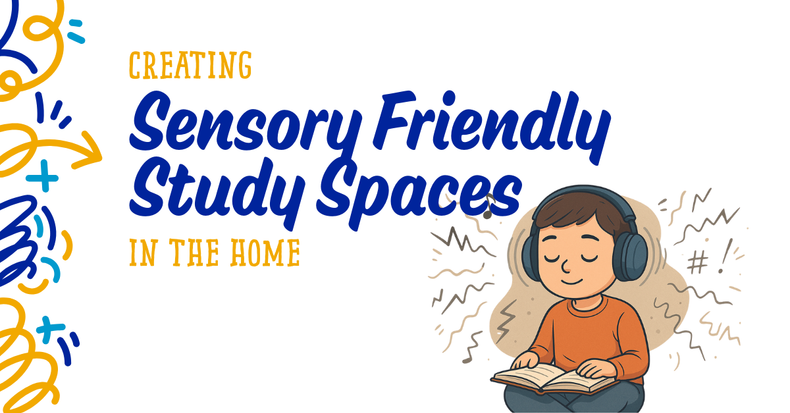Creating a sensory-friendly study space at home can help students stay focused, calm, and ready to learn. A well-planned learning area makes it easier for children to manage distractions and build positive study habits. Families, teachers, and therapists often find that simple changes in the environment can make studying at home more successful.
1. Pick a Quiet Location for Learning
Choose a calm area of your home where your child can work without interruptions. Avoid high-traffic areas such as the kitchen or living room where sounds and movement can break concentration. A small desk in a quiet bedroom corner is often a good choice.
Tip: Involve your child in choosing the space. When children help set up their study area, they are more comfortable and more likely to use it.

2. Control Noise Levels
Background noise is one of the biggest barriers to focus. Tools like noise-reducing earmuffs can help students block out distractions. For children who are sensitive to sound, quiet background music or white noise may also be calming.
3. Provide Sensory Seating Options
Movement-friendly seating supports focus by giving students a safe way to release energy without leaving their study space. These seating options encourage small, controlled movements that improve posture, build core strength, and help regulate attention. Some effective choices include:
-
Wobble Cushions that allow for gentle side-to-side or back-and-forth movement while sitting at a desk
-
Balance Pods that provide quiet foot fidgeting and sensory feedback during lessons or homework
These tools are especially helpful for children who find it hard to sit still for long periods of time. By keeping the body active in a subtle way, movement seating helps students release restlessness while keeping their focus on reading, writing, or problem-solving.
4. Add Calming Deep Pressure Tools
Deep pressure can reduce anxiety and help students feel grounded. A weighted stuffed animal or a lap pad provides gentle pressure that makes studying feel less stressful. These tools are especially helpful during longer assignments or reading time.
5. Organize the Space Visually
Too much clutter can be overwhelming. Keep supplies in bins or baskets, and use calm colors that create a low-stimulation environment. A clear desk surface with only essential materials helps students stay on task.

6. Offer Quiet Fidget Tools
Fidgets give students a way to self-regulate without disrupting study time. Choose quiet items such as stress balls, textured chew toys, or a hand exerciser. These can help students release nervous energy while keeping their attention on schoolwork.

7. Build a Consistent Routine
A sensory-friendly study space works best when paired with a routine. Encourage your child to start homework at the same time each day. Use visual schedules, timers, or checklists to give structure and predictability.

Why a Sensory-Friendly Study Space Matters
When students have a calm and supportive environment, they are better able to focus, manage emotions, and complete learning tasks. Parents and teachers can make small adjustments that have a big impact on success at home and at school.
A sensory-friendly study space benefits every learner, but it is especially important for children who experience sensory challenges, ADHD, or anxiety. With the right setup, students feel safe, supported, and ready to learn.

Explore Sensory Tools for Home Learning
AdaptStore carries a wide selection of sensory tools for focus and calming, including weighted toys, ear protection, wobble cushions, and fidget kits. These products help families create the ideal home learning space.




